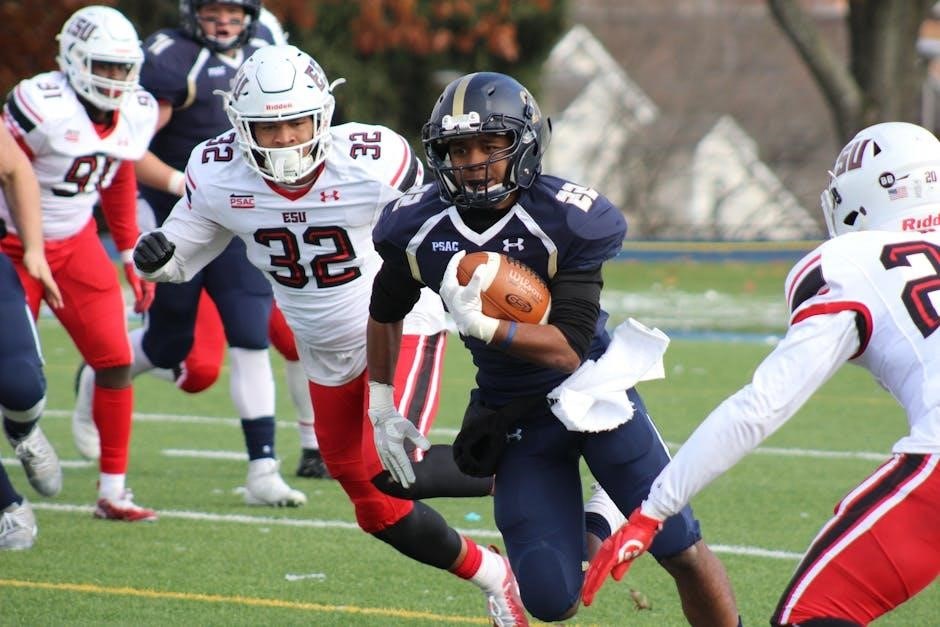The spread offense playbook is a versatile, modern system emphasizing speed and spacing. It uses formations and motions to create mismatches and exploit defensive weaknesses effectively.
1.1 Overview of the Spread Offense
The spread offense is a dynamic, modern football strategy emphasizing speed, spacing, and mismatches. It features wide receivers spread across the field, creating defensive challenges. This system is adaptable to various skill levels, from youth to professional leagues. Key elements include formations like 3- or 4-wide sets, motion shifts, and a mix of run and pass plays. The offense aims to attack defensive weaknesses through precise route combinations and read concepts. Its simplicity allows for quick installation and execution, making it a popular choice for teams seeking versatility and efficiency.
1.2 Importance of the Spread Offense in Modern Football
The spread offense has become a cornerstone of modern football, offering teams a versatile and high-scoring system. Its emphasis on spacing and mismatches allows offenses to exploit defensive weaknesses effectively. The spread offense is particularly valuable in today’s game, as it accommodates various skill levels and playing styles. By creating a balanced attack through run and pass options, it challenges defenses to cover the entire field. Its simplicity and adaptability make it a preferred choice for teams seeking consistency and explosive plays in competitive leagues.

Fundamentals of the Spread Offense
The spread offense relies on formations, spacing, and player movement to create mismatches. Its core principles include simple rules, quick execution, and leveraging speed and agility effectively.
2.1 Key Concepts and Principles
The spread offense revolves around core principles like spreading the field to create mismatches and utilizing motion to exploit defensive weaknesses. It emphasizes simple, executeable rules for players, allowing them to play fast. Key concepts include reading defensive alignments, leveraging speed and agility, and balancing run and pass plays. The system thrives on quick decisions and precise execution, ensuring flexibility against various defensive schemes while maintaining a balanced attack.
2.2 Formation Alignments and Personnel Groupings
The spread offense utilizes multiple formations, such as 3-wide, 4-wide, and shotgun sets, to create mismatches and stretch defenses. Personnel groupings vary, often featuring receivers, tight ends, and running backs in dynamic alignments. These formations emphasize speed and agility, allowing for flexibility in attacking defensive schemes. By aligning players in multiple positions, the offense creates confusion and forces defenses to adjust, enabling the quarterback to exploit weaknesses effectively. Formation diversity is key to maintaining a balanced and unpredictable attack.

Running Game in the Spread Offense
The running game in the spread offense focuses on simplicity and execution, featuring core plays like 24/25 Power and 22/23 Read. These schemes exploit defensive fronts efficiently.
3.1 Base Run Plays: 24/25 Power and 22/23 Read
The 24/25 Power and 22/23 Read are foundational run plays in the spread offense. The 24/25 Power features a pulling guard and tight end blocking to create a seam. The 22/23 Read relies on the quarterback reading the defensive end to decide whether to hand off or keep. These plays are designed to attack defensive fronts like 4-3 and 3-4, emphasizing physical blocking and quick decision-making. They form the backbone of the run game, allowing for consistent gains and controlling the tempo of the game effectively.
3.2 Blocking Schemes Against Common Defensive Fronts
Blocking schemes in the spread offense are tailored to counter various defensive fronts. Against a 4-3 front, linemen target the defensive tackles and ends, while tight ends and receivers block linebackers. For a 3-4 front, double-teams on nose tackles and outside linebackers create seams. Zone blocking is used to neutralize aggressive linebackers, ensuring consistent rushing lanes. These schemes emphasize quick execution and adaptability, allowing offenses to maintain balance and exploit defensive weaknesses effectively in different game situations. Proper blocking is crucial for the success of the run game.

Passing Game in the Spread Offense
The spread offense passing game emphasizes quick reads and route combinations to create mismatches. It relies on simplicity and precision, allowing players to execute at high speed.
4.1 Pass Concepts and Route Combinations
The spread offense passing game relies on a variety of pass concepts and route combinations to attack defenses. Key concepts include the “Mesh,” “Flood,” and “Slant” routes, designed to exploit defensive coverage weaknesses. Route combinations often feature high-low reads, allowing the quarterback to quickly identify open receivers. These concepts emphasize simplicity and execution, enabling players to operate at high speed; By aligning receivers in multiple positions, the offense creates mismatches and forces defenders to make quick decisions. This approach maximizes efficiency and explosiveness in the passing game.
4.2 Attacking Defensive Coverages
Attacking defensive coverages in the spread offense involves identifying and exploiting weaknesses through specific pass concepts. The offense uses formations and motions to force defenses into predictable alignments. Flood concepts, such as “Flood” and “Slant,” are designed to target specific coverage areas. By aligning receivers in multiple positions, the offense creates mismatches and forces defenders to make quick decisions. The quarterback reads the defense pre-snap and post-snap, delivering the ball to the open receiver. This approach allows for efficient exploitation of both man-to-man and zone coverages, maximizing scoring opportunities.

Play-Action and Screen Passes
Play-action and screen passes complement the run game, creating deception and exploiting defensive aggressiveness. These plays keep defenses guessing and control the game’s tempo effectively.
5.1 Play-Action Pass Concepts
Play-action passes are designed to complement the run game by creating deception. They often mimic base run plays like 24/25 Power and 22/23 Read, freezing linebackers and safeties. These concepts exploit defensive aggressiveness, allowing receivers to exploit open zones. Motion and shifts can enhance play-action effectiveness, forcing defenses to hesitate. Play-action passes are particularly effective in controlling the game’s tempo and balancing the offense, making them a cornerstone of the spread offense playbook’s passing strategy.
5.2 Screen Passes to Complement the Run Game
Screen passes are a dynamic complement to the run game, exploiting defensive aggressiveness. They involve quick throws to receivers or backs, often behind the line of scrimmage. Tunnel and bubble screens are particularly effective, using speed and blocking to create big plays. These passes keep defenses honest, preventing them from over-committing to stopping the run. Screens also provide a high-percentage completion rate, maintaining rhythm and controlling tempo. They are a key component of the spread offense, balancing the attack and maximizing offensive efficiency. Proper timing and execution are critical for success.

Motions and Shifts
Motions and shifts enhance offensive flexibility, creating mismatches and exploiting defensive weaknesses. These pre-snap adjustments force defenses to react, simplifying reads for the quarterback.
6.1 Using Motion to Create Mismatches
Motion is a critical component of the spread offense, designed to create mismatches and exploit defensive weaknesses. By moving players pre-snap, the offense forces defenders to adjust, revealing their strategy. This allows the quarterback to identify and attack the defense’s weakest points. Motion also creates confusion, making it harder for defenders to anticipate the play. Simple rules for motion ensure players execute quickly, while the constant threat of movement keeps defenses guessing, enhancing the offense’s unpredictability and effectiveness.
6.2 Pre-Snap Shifts to Confuse Defenses
Pre-snap shifts are a powerful tool in the spread offense, designed to confuse and disrupt defensive alignments. By shifting formations or personnel before the snap, the offense forces defenses to adjust on the fly. This creates hesitation and potential mismatches, as defenders scramble to realign. Shifts are often tied to specific play calls, making them easy to teach but difficult for defenses to anticipate. The goal is to keep defenses guessing, forcing them to play vanilla or risk overcommitting to a particular look, ultimately simplifying reads for the quarterback and creating advantageous situations for the offense.

Specialized Plays
Specialized plays include trick plays and gadget plays designed to exploit defensive weaknesses. These plays create unpredictability and are often used in critical situations to gain an edge.
7.1 Trick Plays and gadget Plays
7.1 Trick Plays and Gadget Plays
Trick plays and gadget plays are designed to exploit defensive weaknesses through deception. These include reverse passes, flea-flickers, and double passes. They create unpredictability, forcing defenses to react quickly. Proper execution relies on precise timing and teamwork. These plays are often used in critical situations to gain a competitive edge. By incorporating trick plays, the offense keeps defenses guessing, adding an extra layer of complexity to the spread offense playbook. They are key to maintaining offensive momentum and capitalizing on defensive vulnerabilities.
7.2 Goal-Line and Short-Yardage Situations
In goal-line and short-yardage situations, the spread offense emphasizes physicality and precision. Power runs, such as 24/25 Power, are often used to punch through defenses. Play-action passes, like bootlegs, exploit defensive aggressiveness. Tight formations with extra linemen or tight ends can reinforce blocking. These situations require disciplined execution, as space is limited. The offense must win at the point of attack, leveraging blockers’ technique and runners’ vision to secure critical conversions and touchdowns, making these plays pivotal in game outcomes.

Defensive Strategies Against the Spread Offense
Defenses counter the spread offense by using nickel packages, blitzing, and man-to-man coverage. They also adjust defensive fronts and employ pattern-matching schemes to confuse quarterbacks.
8.1 Common Defensive Adjustments
Defenses often adjust to the spread offense by employing nickel packages, blitzing linebackers, and using man-to-man coverage. They also shift defensive fronts to 4-2-5 or 3-4 alignments to match the offensive speed. Additionally, defenses utilize pattern-matching schemes to confuse quarterbacks and disrupt timing routes. Simplified rules allow players to react quickly, while pre-snap shifts and motions force defenses to declare their intentions early, creating opportunities for offensive exploitation. These adjustments aim to counter the spread’s speed and spacing by applying pressure and limiting open receivers.
8.2 How to Counter Defensive Schemes
To counter defensive schemes, offenses use motion and shifts to create mismatches and exploit weaknesses. Quick passes and screens complement the run game, while play-action passes attack aggressive defenses. Reading defensive alignments and adjusting blocking schemes ensures execution. Tempo and formation diversity force defenses to simplify, creating opportunities for big plays. By attacking the defense where it is weakest, the spread offense maintains its effectiveness despite common adjustments like nickel packages and blitzing linebackers.

Practice and Drills
Installing the spread offense in 3-5 days ensures quick execution. Drills like tempo exercises and route running improve speed and precision, enhancing overall performance.
9.1 Installing the Offense: A 3-5 Day Plan
Installing the spread offense playbook within 3-5 days focuses on simplicity and repetition. Day 1 introduces base formations and key concepts. Day 2 covers core run plays like 24/25 Power and 22/23 Read, along with blocking schemes. Days 3-4 focus on pass concepts and defensive adjustments. Day 5 refines execution with tempo drills and scrimmage situations. Repetition builds muscle memory, allowing players to perform quickly and confidently. This structured approach ensures a smooth transition and rapid readiness for game situations.
9.2 Drills to Improve Execution and Speed
Drills like tempo exercises and ball-security circuits enhance execution and speed in the spread offense. Route-running drills refine receivers’ precision, while QB footwork and delivery drills improve accuracy. Linemen engage in blocking sleds and mirror drills to perfect technique. Repetition builds muscle memory, allowing players to execute plays faster. These drills ensure the offense operates seamlessly, with each player understanding their role and executing it swiftly and effectively.
The spread offense playbook offers a dynamic, adaptable system for modern football, emphasizing speed and precision. Continuous improvement and strategic adjustments ensure long-term success and effectiveness.
10.1 Summary of Key Points
The spread offense playbook revolves around simplicity, speed, and strategic adaptability. It emphasizes core run plays like 24/25 Power and 22/23 Read, complemented by effective pass concepts. Formations and motions are utilized to create mismatches and confuse defenses. The system is designed for quick installation, allowing teams to focus on execution and tempo. By integrating play-action passes and screens, it balances explosiveness with consistency, making it a versatile and dominant offensive strategy in modern football.
10.2 Continuous Improvement and Adaptation
The spread offense playbook requires ongoing refinement to stay ahead of defensive strategies. Coaches must study opponents, adapt plays, and incorporate successful concepts. Continuous learning through film analysis and practice drills ensures players execute efficiently. By evolving the playbook with new schemes and refining existing ones, teams maintain a competitive edge. Adaptation is key to sustained success, ensuring the offense remains dynamic and unpredictable, keeping defenses guessing and capitalizing on their weaknesses effectively over time.

Additional Resources
Explore detailed playbooks, online forums, and coaching guides for advanced strategies. Websites like completeheadcoach.com offer PDF resources and drills to enhance your spread offense execution.
11.1 Recommended Reading and Playbooks
For a deeper understanding, explore resources like the Power Spread Offense Sample Chapters and Spread Offense Playbook by Brad Underwood. These materials provide detailed insights into formations, blocking schemes, and play concepts. Additionally, the Football-Offense Spread Playbook offers practical strategies for installing and executing the spread offense effectively. These resources are essential for coaches and players aiming to master the system and adapt it to their team’s needs.
11.2 Online Communities and Forums
Online communities and forums are invaluable for discussing and refining the spread offense playbook. Platforms like Reddit’s r/footballcoaching and specialized Facebook groups offer spaces to share strategies, ask questions, and learn from experienced coaches. Websites such as Coach’s Clipboard and Gridiron Strategies provide detailed play designs and adaptations. These resources foster collaboration and innovation, helping coaches stay updated on the latest trends and techniques in the spread offense.
